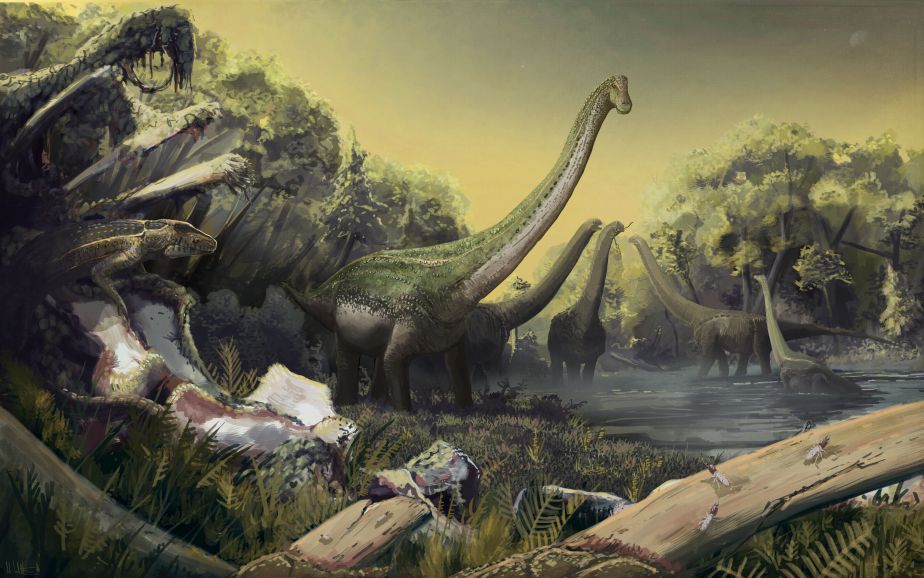Media Releases
JCU scientists help find new species of dinosaur

JCU staff and students have helped uncover the story of a huge new species of dinosaur in Africa.
The approximately 20-metre long titanosaur was found in Tanzania and is believed to have lived 70-100 million years ago. The Journal of Vertebrate Palaeontology will officially announce the findings on Friday, 25 August.
Head of Geoscience at JCU, Associate Professor Eric Roberts, working with Ohio University and in company with JCU students Cassy Mtelela, Hannah Hilbert-Wolf, Leigh Lawrence and Theresa Orr, investigated the new discovery and the geology of the rift system it was found in.
“Titanosaurs are known from all over the world and best known from South America, but fossils of this group are particularly rare from the African continent,” said Dr Roberts.
He said ancient insects bored into the bones of the dinosaur, officially known as Shingopana songwensis, shortly after its death.
“This gave us a CSI-like opportunity to study the skeleton and reconstruct the timing of death and burial, as well as providing rare evidence for ancient insects and complex food webs during the age of dinosaurs.”
The Rukwa Rift Basin Project is an international collaborative between Dr Roberts and Ohio University Heritage College of Osteopathic Medicine professors Drs. Patrick O’Connor and Nancy Stevens.
Dr Roberts said it had provided exciting opportunities to help train JCU Honours and PhD students in field paleontology and geology over the last five years.
The first part of the Shingopana skeleton was excavated in 2002 and represents the first significant discovery by the Rukwa project.
Over the next few years of excavation, additional portions of the skeleton, including neck vertebrae, ribs, a humerus, and part of the lower jaw, were recovered.
“There are a couple of key anatomical features only present in Shingopana and several South American titanosaurs but that are absent in other African titanosaurs,” said lead author Dr. Eric Gorscak, a recent PhD graduate of Ohio University and now post-doctoral researcher at the Field Museum of Natural History in Chicago.
“Shingopana had siblings in South America, whereas the other African titanosaurs were only distant cousins,” he said.
Detailed comparison of Shingopana with other known sauropod dinosaurs suggests that the species found in southern Africa are certainly more diverse than previously thought. The team conducted phylogenetic analyses in order to understand the evolutionary relationships of these and other known titanosaurs.
What they discovered is that Shingopana was more closely related to titanosaurs of South America than to any of the other species currently known from Africa or elsewhere.
“We are still only scratching the surface with regard to understanding the diversity of organisms and the environments in which they lived on the African continent during the Late Cretaceous. And getting students involved in research and encouraging them to develop their own projects is one sure way of better addressing this knowledge gap,” said Patrick O’Connor.
The authors said there appears to be a division between northern and southern African animal and plant life during the tectonically active Cretaceous Period.
Southern Africa first experienced Madagascar and Antarctica splitting off to the east and south, followed by a gradual northward ‘unzipping’ from South America. All the while northern Africa maintained a land connection with South America, as southern Africa progressively became more isolated until the two continents completely separated 95-105 million years ago. Other factors such as terrain and climate may have further isolated southern Africa.
The study was funded by the National Science Foundation, the National Geographic Society, the Jurassic Foundation, The Paleontological Society, Ohio University Student Enhancement Award, Ohio University Original Work Grant, the Ohio University Heritage College of Osteopathic Medicine, the Ohio University Office of the Vice President for Research and Creative Activity, and the College of Science and Engineering at James Cook University.
An illustration and images from the dig site in Tanzania here.
Links to other NSF news related to the Rukwa Rift Basin Project.
Link for Rukwatitan bisepultus—new sauropod dinosaur, Rukwa Rift Basin Project.
https://www.nsf.gov/news/news_summ.jsp?cntn_id=132512
Link for Pakasuchus kapilimai—mammal-like crocodile, Rukwa Rift Basin Project.
https://www.nsf.gov/news/news_summ.jsp?cntn_id=117392
Link for early evidence for monkey-ape split, Rukwa Rift Basin Project.
https://www.nsf.gov/news/news_summ.jsp?cntn_id=127930
Link for early evidence of insect farming—Fossil Termite Nests, Rukwa Rift Basin Project
https://www.nsf.gov/news/news_summ.jsp?cntn_id=138928
Other related links:
Contacts:
Theresa Orr (JCU)
Theresa.orr@my.jcu.edu.au
Note: Ms Orr works from JCU’s Cairns campus. She has assisted at digs in Tanzania, and has examined the site where the dinosaur was found. But she was not on the site when the titanosaur was discovered.
Associate Professor Eric Roberts (JCU)
eric.roberts@jcu.edu.au